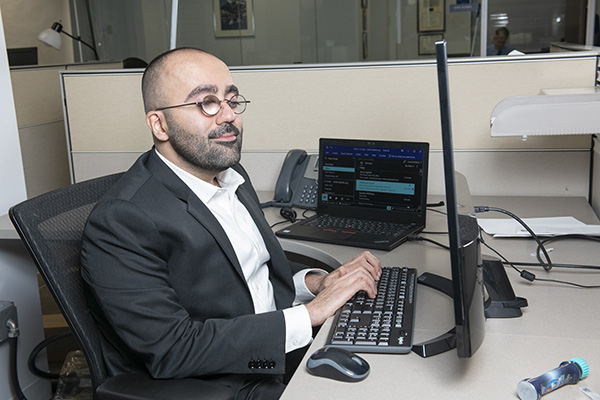
Wednesday, April 14, 2021, is National Assistive Technology (AT) Awareness Day. AFB is committed to increasing access to AT and other accessible technologies as part of our public policy advocacy, and AccessWorld frequently features new technologies in its monthly issues. In honor of the day, we are highlighting what assistive technology means to people who are blind or have low vision. For those who already use assistive technology, we also encourage you to spread the word and raise awareness about how you use AT.
What Is Assistive Technology?
Assistive Technology (AT) is any item, piece of equipment, or system that is used to increase, maintain, or improve the functional capabilities of individuals with disabilities and older adults. Common examples of AT include software and hardware like screen readers and magnifier devices, but in the broadest sense, AT also incorporates signature guides, proper lighting, and white canes.
How Do People Use Assistive Technology in Their Daily Lives?
Amir Rahimi uses AT to be independent at home, in the community, and at work. When asked why AT is important, he wrote, “I thought my life was practically over after abruptly losing my vision over a decade ago. However, with the help of assistive technology, I’ve been able to live an independent and fulfilling life. Thanks to my screen reader and magnification software, I was able to finish grad school at the top of my class and gain meaningful employment. My white cane allows me to independently go to work, the grocery store, on adventures to my favorite hiking trails, and take solo trips to destinations such as Miami and Hawaii. Individuals in the blind and low vision community are faced with barriers on a daily basis. Assistive technology helps remove many of these challenges—allowing people in the BVI community to achieve everything they want in life. Simply put, AT helps blind and low vision people overcome society’s misconceptions about us, particularly around our ability to be a productive employee, own a home, and start our own families.”
Disability is defined by the negative interactions between a person with a health condition and environmental factors, such as negative attitudes or inaccessible buildings, transportation, or digital platforms. Assistive technology improves these environmental interactions and removes barriers in just about every facet of life. Whether reading a book, cooking dinner, navigating an airport, emailing colleagues, or solving a math problem, the list goes on and on.
How Do People Get Access to Assistive Technology?
Students may receive AT as part of the technology outlined in their individualized education program (IEP). Employees may be able to work with employers to receive AT as part of a reasonable accommodation that enables an employee to perform their job. Rehabilitation programs may help pay for AT and the accompanying training to help people get jobs. Specialized educators and rehabilitation professionals are trained to evaluate an individuals’ skills, existing equipment, and needs to ensure that they have access to both the AT itself and the training to use it. State AT Programs help people become familiar with specific types of AT and can provide devices loans, financing, and sometimes access to free or low-cost AT.
Beyond these services, there are many technologies that can be accessed at a low cost and without specialized training, such as scanner and OCR apps that are free for someone who already has a smartphone, which typically has a built-in screen reader and other accessibility features. Staying connected with others in the blind and low vision community or reading AccessWorld can help you stay up-to-date on new options.
How Can You Get Involved Today?
National AT Awareness Day is a great opportunity to share with lawmakers how important AT is for blind and low vision people. Take this chance to contact your Member of Congress to ask that they support funding for assistive technology through the Assistive Technology Act and share with them how AT plays a role in your own life. Call them today at 202-224-3121!
Sample Script:
“Hi, my name is [your name] and I live at [address]. I’d like to ask Senator/Representative [Last Name] to support funding for assistive technology through the Assistive Technology Act. [Tell a brief story that shows how you use AT and/or why it is important to you]. Thank you for your support!”
You can also share about AT with your friends and family by talking about AT on social media. Take a pic or share a story to raise awareness about how important AT is to you and include the hashtag #ATAwarenessDay. Feel free to link to this blog to share the facts, leaving you space to tell a story!